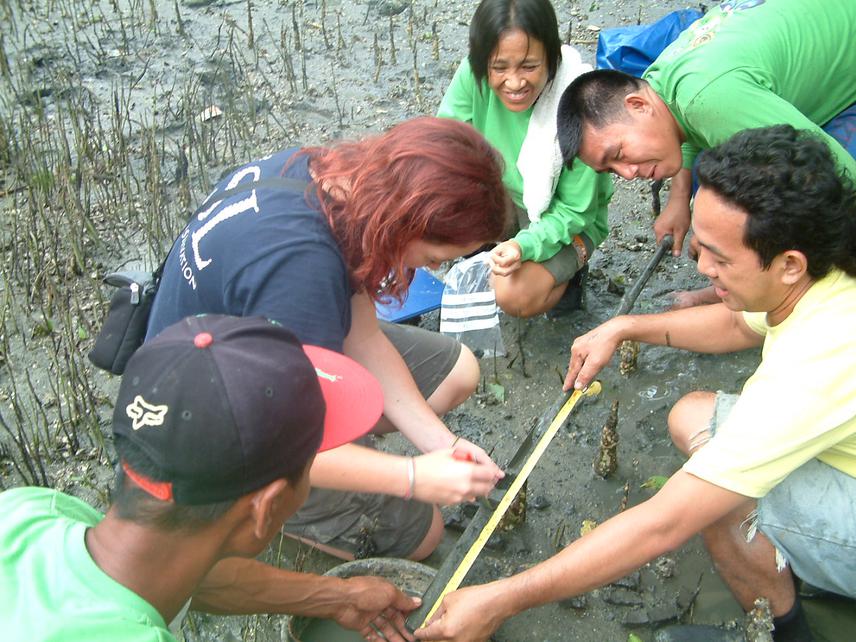Clare Duncan
This project will provide vital information on the ecosystem services provision of restored and natural mangrove forests on Panay Island, Philippines, as well as building local community-based restoration and monitoring capacity. The aim of the project is to improve knowledge on how restoration design influences mangrove ecosystem services provisioning, in order to improve the ability of the mangroves to protect communities from the future impacts of climate change.

Leganes Municipality Local Government Unit staff being trained in mangrove sediment coring for organic carbon content in Barangay Ermita, Dumangas, Iloilo Province. © Venus Sadio Calanda, ZSL.
Across the Philippines, widespread land conversion has decimated much of the natural mangrove [1]. Yet in light of the 2013 devastation caused by super-typhoon Yolanda, the importance of mangrove forests in providing Philippines’ local communities with vital coastal ecosystem services (ES, such as food provisioning, carbon sequestration and storm and flood attenuation) has never been made so obvious.
Since 2006, the Zoological Society of London (ZSL) has been involved in community-based mangrove rehabilitation projects across Panay Island (Primavera 2012. ISBN: 978-971-95370-1-4). The recent devastation of many local villages following Yolanda, however, suggests that some restored mangrove forests in the area may not be highly functional in terms of mitigating storm damage. Various factors could explain this lack of functionality: plant diversity; structural complexity; biomass; age; configuration. So far, however, little is known about the relative importance of these factors in shaping mangrove health and ES provision. In the face of climate change and increased pressures on coastlines, such research is yet essential to inform future restoration strategies.
This project will utilise inter-disciplinary (field- and satellite-derived) approaches to explore factors shaping mangrove services provision, producing training and documentation to improve the success of community-based restoration efforts.
This project will:
- Collect information on the ES provision of restored and natural mangrove forests, namely carbon content (vegetation and soils) and storm attenuation.
- Collect information on the abundance, diversity and distribution of under-studied ecosystem engineering Uca fiddler crab species.
- Train five local Research Assistants (RAs) in methods of biodiversity monitoring (crabs), and storm damage and mangrove carbon stock assessments.
- Produce a training manual for mangrove carbon monitoring and assessment for use by future students, researchers and practitioners in the region, including information on Philippines-specific best-practice advice regarding equipment, methodologies and administrative procedures.
- Produce a local guide to mangrove invertebrates and their roles in mangrove ecosystems. During crab surveys and soil carbon sampling, photographs will be taken of important ecosystem engineering species (grapsid and fiddler crabs, soil-living detritivores and molluscs), and an educational guide will be researched and produced (English and Tagalog) for use by local communities and schools to encourage understanding of the importance of mangrove invertebrate diversity.
- Produce guideline documents for future community-based mangrove replanting efforts to improve ES provision, with information on the importance of structural composition, mangrove species diversity, and site configuration of sites in determining restored mangrove health.